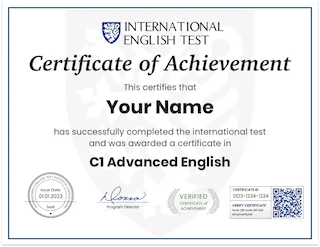Get ready to dive into the world of common English running terminology with this indispensable guide. Additionally, discover ways to enhance your overall language proficiency.
Running remains a popular exercise globally, with 50 million Americans engaging in running or jogging in 2022. Its accessibility, requiring only a good pair of shoes, makes it a favored choice for fitness, calorie burning, and stress relief after a day’s work.
This article will guide you through fundamental running terminology in English, encompassing aspects from clothing to running jargon. Acquiring a solid understanding of running vocabulary enables you to explore and comprehend techniques that can enhance your running performance. So, continue reading to delve into the basics of running terminology.
What is your English level?
Find out your A1 A2 B1 B2 C1 C2 level of English with our online test and receive your English certificate.
Basic running terminology
If we simplify the description of running, it could be expressed as “moving your body forward at a specific speed for a certain distance.” This fundamental explanation serves as a great introduction to key running terminology. Here are additional crucial concepts to grasp when engaged in running:
Distances and speed
Distances and speed are integral considerations for nearly every runner. Whether you aim to participate in competitions or engage in conversations with fellow runners, it’s essential to comprehend the terminology associated with these aspects:
- Meter
- Kilometer
- Mile
- Speed
- Pace

Running form
Form pertains to how you manage and position your body while running. Maintaining proper form can enhance your running speed and endurance, whereas incorrect form may subject your body to stress and potential injuries. The following terms introduce key elements of running form:
- Stride
- Footstrike
- Heel Strike
- Midfoot Strike
- Forefoot Strike
- Posture
- Arm swing
Are you C1 Advanced English?
Get your C1 Advanced English certificate now!
✓ Add your certificate to your resume
⭐ ⭐ ⭐ ⭐ ⭐
Running gear and equipment
Utilizing the correct running gear can enhance your performance, prevent injuries, and instill confidence. However, given the various types of running, selecting the appropriate equipment requires time and effort.
Whether you’re conquering steep mountainsides or covering extensive distances on professional tracks, this compilation of running vocabulary in English will aid you in choosing the right gear for the task:
Shoes
Footwear stands as the crucial component of your running attire, as it directly interacts with various terrains. Here are some commonly encountered types of running shoes:
- Cushioned shoes
- Stability shoes
- Lightweight shoes
- Trail running shoes
Apparel
Running attire serves a purpose beyond aesthetics. Opting for the right clothing is essential to guarantee comfort during your runs, enhance wind resistance, and keep you dry on rainy days.
We’ve covered three of the most essential types of running gear:
- Running shorts
- Running Tights
- Running Tops
Accessories
Runners aim for a lightweight and unencumbered experience, typically minimizing accessories. However, three items are often deemed essential by many runners.
- Running Watch
- Running Headphones
- Running Armband

Running events and races
Whether you aspire to compete professionally, participate in charity events, or challenge yourself under timed conditions, understanding race vocabulary is crucial. While many races are named based on distance, we’ll also guide you through essential race terminology that can be useful during competitions.
Types of races
- 5k (5 kilometers): The 5k (approximately 3.1 miles) race is perhaps the first significant running milestone and is often a stepping stone for runners looking to build endurance and progress to longer distances.
- Half Marathon: A half marathon is a long-distance race that covers a distance of approximately 21km (13.1 miles). It offers a significant challenge for runners while being more accessible than a full marathon.
- Marathon: A marathon is a challenging long-distance race that covers a distance of approximately 42.2km (26.2 miles). It’s the ultimate endurance test for runners and requires months of training.
Race terminology
- Passing
- Starting Position
- Kick
Advanced running terms and concepts
Much of the running vocabulary might not be pertinent for beginners but becomes crucial for experienced runners seeking a comprehensive understanding of their performance and the ability to refine their technique and training approaches. Here, we’ve compiled some of the most common advanced running vocabulary.
VO2 Max
VO2 Max, or maximal oxygen uptake, quantifies the highest volume of oxygen an individual can consume during intense physical activity. This metric serves as an assessment of cardiovascular fitness and endurance, commonly presented as milliliters of oxygen per kilogram of body weight per minute (ml/kg/min).
Cadence
Cadence denotes the count of steps or strides a runner completes within a minute, typically measured in strides per minute (SPM). This metric holds significance in running, influencing efficiency and injury prevention. A higher cadence, typically falling within the range of 170 to 180 steps per minute, is often correlated with decreased impact and improved running form.
Fartlek
Fartlek represents a training method incorporating fluctuations in workout intensity and speed. This technique combines intervals of faster-paced running with slower recovery phases. Fartlek workouts are typically flexible, enabling adjustments in speed and intensity based on personal feelings or encountered terrain. This approach contributes to enhancing aerobic and anaerobic fitness, speed, and mental resilience.

Summary
We’ve explored key running terminology to boost your confidence on the road or track. Whether you’re tracking your pace or selecting the right gear, you’re now equipped to navigate the world of running in English. To elevate your English further, explore our diverse pool of certified online English tutors. Customize your search based on schedule and budget, and consider a trial lesson to ensure the perfect match – it’s an uncomplicated process.
What is your English level?
Find out your A1 A2 B1 B2 C1 C2 level of English with our online test and receive your English certificate.
I am Nilay, an experienced English Language Assessment Director at the International English Test, where I have been working full-time since February 2020. I specialize in helping people worldwide validate their English proficiency through comprehensive assessments and certifications.
Before joining the International English Test, I worked as a self-employed English Language Assessment Consultant from January 2015 to December 2019. During this time, I assisted companies and individuals in improving their language skills, helping them achieve their academic and professional goals.
I hold a degree in Engineering and have also studied at Shafston International College in Australia. My educational background has equipped me with the tools to make a meaningful impact in the field of English language learning. Additionally, I enjoy sharing my expertise through articles that explore effective teaching methods and language assessment strategies, contributing to the International English Test and the broader assessment community.





